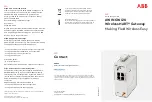
105 Radio/Serial Telemetry Module
User Manual
Page
20
©
January 2004
2.4.6
Pulse Input (105-1)
For the 105-1 module, digital input 1 may be configured as a pulse input (max rate 100 Hz, min. off
time 5 ms). In this mode, both the pulse
rate
and the pulse
count
are available for mapping to a
remote output. The pulse rate may appear at any analogue output on the remote unit, while the
pulse count can appear at a Pulse Output on another 105-1 or Digital Output on a 105-3 unit. The
pulse input should be connected in the same way as a digital input.
Active pulse signals can be connected directly provided the peak voltage is between 3.5–13V and
the low voltage is less than 1.5V. Note that the 105U will ground the negative of the pulse signal.
If the voltages are not compatible, use a solid state relay to isolate the two devices.
2.4.7
Pulse Inputs (105-2 and 105-4)
For the 105-2 and 105-4 modules, the four digital inputs (DI 1-4) may be configured as pulse
inputs. The first digital/pulse input DI 1 has a maximum rate of 1000 Hz (min. off time 0.5 ms),
while DI 2-4 have a maximum rate of 100 Hz (min. off time 5 ms). When using DI 1 at high pulse
rates (more than 100 Hz), a divide by 10 function may be configured to reduce the pulse count at
the output, as Pulse Outputs have a maximum rate of 100 Hz.
For each pulse input, both the pulse
rate
and the pulse
count
are available for mapping to a remote
output. The pulse rate may appear at any analogue output on the remote unit, while the pulse count
can appear at a Pulse Output. The default update time for pulse counts is 1 minute. This can be
changed by changing the update time configuration - refer Chapter 4
Configuration
for further
details. The pulse count is a 16 bit value - “roll over” of the count when it exceeds the maximum
value is automatically handled by the 105 modules.
+
_
DI 1
COM
105U
Passive
transistor
device
+
_
+
_
DI 1
COM
105U
External
power
supply
+
_
Active pulse device
Note:
Use a solid
state relay if
the voltage
range is not
suitable.
















































